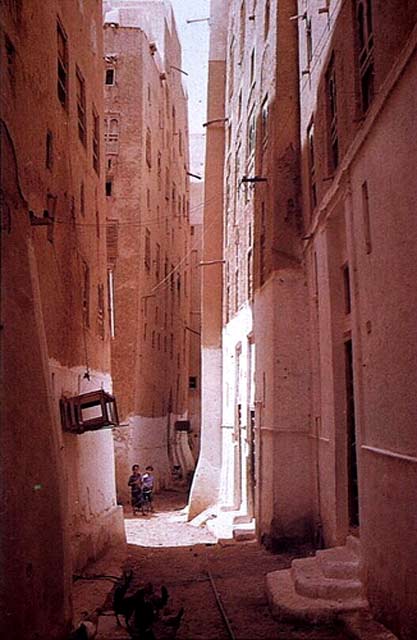Shibam of Yemen
World's First Skyscrapers?Democracy in Yemen did not stop, instead it is in a continuous development. - Ali A Saleh
These were mostly built between the early 14th to the 17th centuries Near the Empty Quarter Desert, between the rocky folds of the mountains, Wadi (valley) Hadramout stretches into the surrounding cliffs. Here, one finds a beautiful portrait, the lines of which were shaped by the artistic hands of ancient Yemenis. Along the length of the Wadi, situated on a plateau in the centre, the city of Shibam rises up, solid and eternal - the first skyscrapers in the world to be made of mud and clay. The clay-formed houses of Shibam are 30 - 40 metres tall, each having between 5 and 16 floors. The ground floors have a wall thickness of up to 2 metres to support the weight of the floors above. The higher floors are usually painted with thick layers of white alabster, while the windows are framed with wood artistically engraved with geometrical designs. The windows are designed to allow air currents entry even when shut. Beneath the rooftops are small windows with shutters that can be opened or closed according to the weather such that the temperature inside the buildings remains fairly constant year-round. Shibam has a surrounding wall 7 metres high with one entrance gate. The internal streets are narrow and curved and made for pedestrians. Source: yemeninfo.gov.ye
Source: deputy-dog.com
Towering Skyscrapers in the "Manhattan of the Desert"Rising from the valley floor like a mirage, the 450-year-old mud brick towers of Shibam in Yemen are the world’s first skyscrapers - dubbed the Manhattan of the Desert. The 500 tower houses, made from mud mixed with chaff and hay, have withstood 113° F (45° C) heat, floods and a recent explosion caused by suspected Islamic militants (that killed 4 South Korean tourists and their local guide). Inside the walled fortress (a Unesco World Heritage Site), the streets are eerily quiet in spite of the 7,000 residents. Families pass silently from building to building high up along connecting corridors built to protect early inhabitants from attacks by Bedouin nomads. Only 2 gateways allow entrance through the city’s protective outer wall. The mud walls of the tower houses - 5 to 8 storeys and up to 130 feet high - are thickest at the bottom for stability. By law, any rebuilding must follow the shape of the original structure. The arched window frames are made from the leafless nabaq tree and some towers are whitewashed with lime to slow down erosion by heat and rain. The city’s design serves as a giant air-conditioning unit, creating maximum shade. Each building is usually used by one family. Food and cattle are kept on the ground and 1st floors. The 2nd storey upwards is a living area, with kitchens and entrances to the corridors on the 4th floor. Source: dailymail.co.uk 21 March 2009
For more articles relating to Money, Politics and Law including globalisation, tax avoidance, consumerism, credit cards, spending, contracts, trust, stocks, fraud, eugenics and
more click the "Up" button below to take you to the page on "How Many Countries in the World?" Clicking "Up" from there will take you to the Index for this section. |
 Animals
Animals Animation
Animation Art of Playing Cards
Art of Playing Cards Drugs
Drugs Education
Education Environment
Environment Flying
Flying History
History Humour
Humour Immigration
Immigration Info/Tech
Info/Tech Intellectual/Entertaining
Intellectual/Entertaining Lifestyles
Lifestyles Men
Men Money/Politics/Law
Money/Politics/Law New Jersey
New Jersey Odds and Oddities
Odds and Oddities Older & Under
Older & Under Photography
Photography Prisons
Prisons Relationships
Relationships Science
Science Social/Cultural
Social/Cultural Terrorism
Terrorism Wellington
Wellington Working
Working Zero Return Investment
Zero Return Investment
